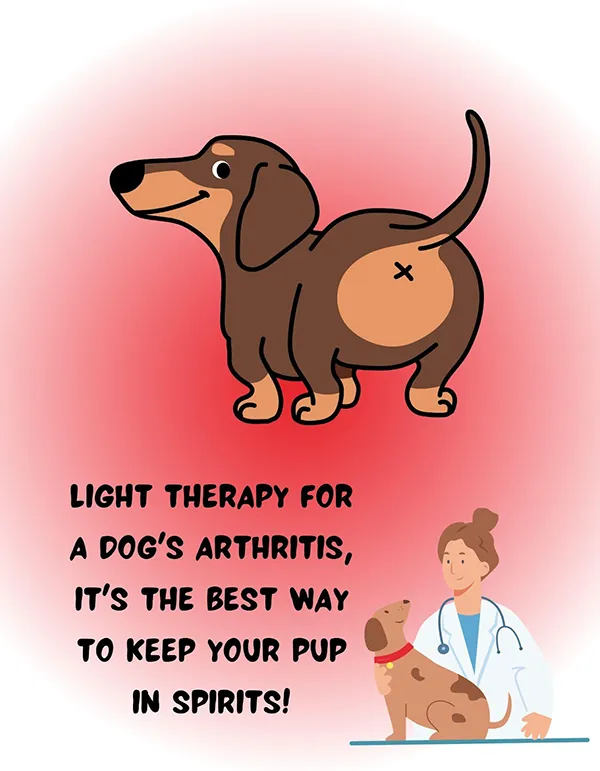
Arthritis can hurt and make it hard to move, not only for people but also dogs. If you’ve noticed that your dog is having trouble moving around or is less active than normal, they may have arthritis.
The good news is that there are different treatments that can help ease your dog’s pain and make their life better.
In this blog, we’ll talk about the causes and symptoms of dog arthritis, as well as the different ways it can be treated, including the use of light therapy and how it can help control this condition.
An Overview to Dog Arthritis
Before we talk about how to treat canine arthritis, it’s important to know what it is and how it affects our furry friends.
Canine arthritis, also called osteoarthritis or degenerative joint disease, is a common illness that mostly affects older dogs but can also happen to younger animals.
It happens when the cartilage that cushions the joints wears away over time, causing pain, inflammation, and less movement. Arthritis can affect any part in a dog’s body, but it most often affects the hips, knees, elbows, and spine.
Ways You Can Tell if a Dog Has Arthritis?
For effective care, it’s important to find arthritis as soon as possible. Here are some common symptoms and signs to look out for:
- Having a limp or favoring one leg
- Stiffness, especially after resting. Less movement and reluctance to play or go for walks.
- Having trouble going up or down stairs or getting up from lying down
- Joints that can be heard cracking or popping
- Joints that are hurt get swollen and hot.
- Changes in behavior, like anger or sadness
If you notice any of these things about your furry friend, you should talk to your vet to get a good diagnosis and talk about treatment options.
Traditional Ways to Treat Arthritis in Dogs
Dogs with arthritis are usually treated in a number of ways that try to reduce pain and inflammation while improving joint function. Here are some popular ways to treat someone with traditional medicine:
- Nonsteroidal anti-inflammatory meds (NSAIDs) like Rimadyl and pain relievers like tramadol can help with pain and inflammation. But these medicines may have side effects and should only be used with the help of a doctor.
- Glucosamine and chondroitin supplements are often suggested to help keep joints healthy and fix cartilage.
- Dogs with arthritis need to stay at a healthy weight because extra weight puts more stress on their joints. A balanced meal and watching how much you eat can help you control your weight.
- Range-of-motion exercises and underwater treadmill therapy are two types of physical therapy exercises that can help improve joint movement and muscle strength.
- Making changes to your dog’s environment, like giving it soft bedding and ramps to make it easier to get to higher places, can help reduce joint pain.
Even though these traditional treatments can help, some pet owners are looking to non-traditional treatments like light therapy to help their dogs with arthritis.
Light Therapy for a Dog’s Arthritis

Light therapy, also called photobiomodulation or low-level laser therapy (LLLT), is a non-invasive way to treat canine arthritis that has shown some promise.
This treatment uses certain wavelengths of light to speed up the activity of cells, lower inflammation, and help tissues heal. Light treatment can help dogs with arthritis in the following ways:
Pain Relief
Light treatment helps endorphins, which are natural painkillers, come out more. This can make your dog much less uncomfortable and improve their general health.
Anti-inflammatory Effects
Light treatment can help reduce swelling and inflammation in the affected joints by focusing on inflammation at the cellular level. This makes moving around less painful.
Better Mobility
Light treatment can improve joint flexibility and function, making it easier for your dog to move around and do things they may have avoided before.
Accelerated Healing
The therapy can help tissues heal and grow back, which could slow the growth of arthritis and make joints healthier over time.
How to Give Light Therapy to Your Dog with Arthritis?
Light treatment can be very helpful, but it’s important to do it right and with the help of a veterinarian or a licensed therapist. Here are some important things to remember:
Advice from Experts
Talk to a vet who has experience with light treatment for dogs. They can give you advice on the best plan of care and make sure the therapy is safe and helpful for you.
Consistency
Light therapy usually takes place over a set number of rounds. Stick to the treatment plan to get the most out of it.
Safety Measures
Keep your dog’s eyes and skin away from the light source while he or she is being treated. Your vet or therapist will tell you what safety steps to take.
Light Therapy Combined with Other Treatments
Light therapy can be a useful part of your dog’s treatment plan for arthritis, but it often works best when it is paired with other methods. Here’s how you can use light therapy along with other treatments:
- Keep giving your pet any medicines as your vet tells you to. Light therapy can make these treatments work better and reduce the amount of medicine that needs to be taken.
- Using light therapy doesn’t mean you have to stop taking joint vitamins. In fact, the two methods can work together to help keep joints healthy.
- Keep doing things like losing weight and doing physical therapy routines that are good for your joints.
Bottom Line
To take care of a dog with arthritis, you need patience, commitment, and a complete treatment plan. Traditional treatments like painkillers and joint supplements are still important, but light therapy is better for managing pain, reducing inflammation, and making it easier for dogs with arthritis.
If your pet has arthritis, you can help them live a happier and more comfortable life by working closely with your vet and considering different treatment choices. Remember that every dog is different, so make sure that the treatment plan fits your dog’s needs. Together, you can give your dog the best care possible.



